
149
HNUE JOURNAL OF SCIENCE
Educational Sciences 2024, Volume 69, Issue 5B, pp. 149-156
This paper is available online at http://hnuejs.edu.vn/es
DOI: 10.18173/2354-1075.2024-0143
THE ROLE OF METACOGNITION IN MATHEMATICAL MODELING PROCESS
Nguyen Thanh Cong1,2
1PhD Candidate of Department of Mathematics, Ho Chi Minh University of Education,
Ho Chi Minh city, Vietnam
2Bui Thi Xuan High School, Ho Chi Minh city, Vietnam
*Corresponding author: Nguyen Thanh Cong, e-mail: ntcong179@gmail.com
Received April 22, 2024. Revised October 11, 2024. Accepted December 27, 2024.
Abstract. The 2018 Mathematics General Education Curriculum includes the following
cognitive activities as the components of the mathematical modeling process: recognizing
mathematical models (such as formulas, equations, tables, graphs, etc.) for situations that
arise in real-world problems; solving mathematical problems using the established model;
presenting and assessing the solution in a real-world context; and improving the model if the
solution is not appropriate. However, for students to carry out the aforementioned procedure,
it’s essential that they engage in a particular kind of activity called metacognition.
Metacognitive activities in mathematical modeling encompass all of the learner's thinking
that takes place throughout the mathematical modeling process. The article presents some
research findings on the role of metacognition in the mathematical modeling process,
including reading and understanding real-life problems, building mathematical models,
solving math problems with the model, and presenting the solution.
Keywords: metacognition, mathematical modeling process, reading comprehension,
strategy selection.
1. Introduction
The term "metacognition," also known as "awareness about awareness" or "thinking about
thinking," was coined in 1976 by American psychologist John Flavell to characterize people's
awareness of their own cognition [1]. Originally, metacognition was primarily explored in
reading, but in the 1980s, metacognition started to be investigated in mathematics education,
particularly concerning problem solving [2]. The first definition of metacognition can be traced
to Flavell (1976): “Metacognition refers to one’s knowledge concerning one’s own cognitive
processes and products or anything related to them (…). Metacognition refers, among other
things, to the active monitoring and consequent regulation and orchestration of these processes in
relation to the cognitive objects on which they bear, usually in the service of some concrete goal
or objective” [1], [3].
Several researchers have developed a number of models of metacognition in an effort to
concretize the concept, namely J. Flavell’s model (1979), Ann Brown’s model (1987), Nelson
and Narens’s model (1990), Tobias and Everson’s model (2002), etc. [4]. More recently,
metacognition is typically classified into two categories: metacognitive knowledge, which is the
awareness of one's past actions, and metacognitive strategies, which are the awareness of one's

Nguyen TC
150
future actions. Metacognitive knowledge comprises declarative, procedural, and conditional
knowledge as well as personal, task, and strategic knowledge. Metacognitive strategies include
planning, monitoring - adjusting, and evaluating.
The mathematical modeling process, similar to the order of manifestations stated in the 2018
Mathematics General Education Curriculum, includes three steps: identifying the mathematical
model (including formulas, equations, tables, graphs, etc.) for situations that arise in real-life
problems; solving mathematical problems within the established model; presenting and assessing
the solution in a real-world context and improving the model if the solution is not appropriate [5].
Numerous international studies have demonstrated the critical role that metacognition plays
in both the capacity and process of mathematical modeling. Stillman (2011) highlights the
significance of metacognitive activities, particularly in shifting from one stage to another in the
modeling process [6], [7]. Blum (2011) states: “Metacognitive activities are not only helpful but
even necessary for the development of modeling capacity” [8], [9]. Riyan Hidayat and colleagues
(2018, 2023) proposed and tested the hypothesis that "Metacognition has a positive influence on
students' mathematical modeling ability" [10], [11]. Katrin Vorh𝑜 later colleagues [4] introduced
the idea of metacognitive modeling competencies, which encompass declarative meta-knowledge
and procedural metacognitive strategies.
The current article presents some research findings on the role of metacognition in the
mathematical modeling process as follows: reading and understanding real-life problems,
building mathematical models, solving mathematical problems, and presenting solutions, through
a task as follows:
"On a visit to Hanoi, Nam was attracted by the unique steel tubular arch construction of the
bridge, which has three main spans with a width of 55m each, and 8 motor vehicle lanes (1).
Please help Nam determine the maximum height of the arch that corresponds to the middle span
of the bridge, given that the distance between the two feet of the middle arch is 77 m (2) and the
height of the arch from the point on the bridge, away from the foot of this arch 16 m, is 12 m (3),
given the tubular arches have a nearly parabolic shape”.
Figure 1. A bridge with parabolic-shaped arches
I chose this problem for two main reasons. First, there were several technical terms relating
to construction and bridge building in the task, such as "bridge spans, steel tubular arch," and the
students had to predict and guess the meaning of these terms when making models. Second, there
were two assumptions: assumption (3) - “the height of the arch from the point on the bridge, away
from the foot of this arch 16 m, is 12 m”, which was difficult for the students to understand, so

The role of metacognition in mathematical modeling process
151
they had more time to finish their own drawings to interpret the assumption; and assumption (1)
- “a width of 55m, and 8 motor vehicle lanes (1)”, which was not related to the problem, which
the students had to realize and simplify. The task provided multiple chances for students to
conduct their metacognitive activities. The experiment was conducted on 112 grade 10 students
at Bui Thi Xuan High School.
2. Content
2.1. Roles of metacognition in the mathematical modeling process
2.1.1. Roles of metacognition in reading and understanding real-life problems
When students begin to solve real-life problems, their first task is to read and comprehend
real-life problems. Being first examined in reading [7], metacognition plays a role in helping
students understand the problem. Specifically, metacognition facilitates learners to organize their
reading, including what to read (the whole text, or some parts, or some keywords, etc.) and how
to read (skimming, reading slowly, reading quickly, reading attentively, reading again, etc.).
Occasionally, these activities happen naturally during reading, without the learner realizing that
they are controlling it. Some researchers have pointed out the difference between good readers
and poor readers: Baker (1989) found that “good readers appear to have better awareness and
control of their own cognitive activities while reading than poor readers” [12], [13]; Long and
Long (1987) reported that “good comprehenders engage in mental interactions with the text
through visualization, self-questioning, and inferring, although poor comprehenders engage in
some metacognitive activities, such as skimming, rereading, and pointing to keywords. They
perform behaviors similar to those of good comprehenders, but without mentally activating
operations needed for understanding” [12].
Furthermore, some researchers have proposed various reading comprehension strategies:
organizational strategies, contextual thinking, reflective thinking, and imagery strategies by Jone,
Amiran, and Katim (1985) [12]; skimming, predicting, visualizing, checking understanding,
clarifying, self-checking content, reviewing, summarizing, activating prior knowledge,
connecting previously knowledge to new information; etc. by Hartman (2001) [12].
In addition to reading text, metacognition also plays a role in helping learners interpret the
meaning of images [14], because in some real-life problems, there may also be pictures, images,
or illustrations. Sometimes, looking at images also makes it easier to absorb and comprehend text
more quickly. In the proposed problem, there are two assumptions relating to construction and
building including "steel pipe arch” and “bridge span"; therefore, it can be challenging for learners
to interpret and determine their meanings without the picture.
2.1.2. Role of metacognition in building mathematical models
In this phase, learners need to identify variables, parameters, and constants (with conditions)
and establish relationships between variables (cognitive activities). Metacognition is important in
helping learners make appropriate decisions and alter decisions if the past decision is found
inappropriate, for example: how many variables to set (one, two, or three variables), which object
to set as the variable (object asked in the question or another object), which mathematical
operations (+, – ×, ÷), power or exponentiation, logarithm, etc.) and which comparison operations
(
, , , , , , =
...) to use, which shape is similar to the object in the problem (triangle, rectangle,
square, circle, rectangular box, etc.). The choice may be made based on students’ experience,
preference, or even the benefits and drawbacks of that choice. For example, sometimes, a problem
can be solved by setting one or two variables, and students can choose based on their preference.
Determining which object to set as a variable is also important, because if students select an

Nguyen TC
152
inappropriate object, the model may get too complex to be solved. In that case, students must
change the way they set the variable to establish a more simple model.
2.1.3. Role of metacognition in solving math problems and presenting solutions
In this phase, metacognition helps learners break the problem down into steps (what to do
first, what to do next) and choose the solution strategies by evaluating the pros and cons of each
strategy. Metacognition assists learners to present, display, and justify the solution by organizing
and arranging the layout of the solution, including determining which parts need to be written
first and which parts need to be written later. Each student has a different layout for presenting
the solution.
2.2. Experiment
2.2.1. Experiment 1 (corresponding to the first role)
Hartman (2001) raised the question “To what extent do students understand what they read
in a text?” [12]. To find out the answer, we designed a small experiment for students to self-assess
their reading comprehension of the Bridge problem.
Table 1. Students’ self-assessment of reading comprehension worksheet
Reading
text
What have
you read?
Level of
understanding
Looking
at images
What did
you look at?
Level of
understanding
First time
Read the
whole task.
First time
Look at the
whole
picture.
2th time
2th time
3rd time
3rd time
...
...
...
...
...
...
The experimental results showed that the students had different ways to express their level
of understanding: using words (81 out of 112 students) such as “not understand yet, understood,
somehow understand, understand a little, understood slightly, understood completely, understand
almost completely, not clear yet, understand clearly, generalize, temporarily understand, etc.”;
using percentages (26 out of 112 students) for example 50%, 60%, 100%, etc., and using fractions
(4 out of 112 students) such as 1/5, 4/5, 5/5, etc. Gradual increases in students’ understanding
after each time reading text or scanning images can be observed. Thereby, it is found that using
percentages to evaluate the reader's level of understanding of the text is the most reasonable.
Figure 2. Samples of students’ completed worksheets
2.2.2. Experiment 2 (corresponding to the second role)
In the Bridge problem, the model chosen for the problem is a quadratic function y = ax2 +
bx + c, with the participation of two variables x, y, parameters a, b, c with the condition a ≠ 0.
So the coordination strategy has been implemented. The question is, where did the students put
the coordinate system?
Read
What have you read?
Level of
understanding
Look
Level of
understanding
Level of
understanding
Level of
understanding
What have you read?
Look
Read
What did
you look?
What did
you look?
Read key word
Read key word and
analysis the picture
Read whole task
Look whole picture
Look whole picture
Look whole picture
Look whole picture
Read whole task
Read whole task
Read whole task
Some details in the
picture

The role of metacognition in mathematical modeling process
153
Table 2. Some strategies to locate the coordinate system
and determine the coordinates of the three points
Strategy
Illustrative diagram
Determining the coordinates of points
A, B, and C
Strategy 1
Simply, you can quickly determine the
coordinates of three points A, B, and C;
Strategy 2
To determine point B, subtraction must be
performed.
Strategy 3
Determining the coordinates of points A,
B, and C requires complex calculations.
Strategy 4
Determining the coordinates of points A,
B, and C is relatively complicated.
Each strategy has its own advantages and disadvantages. If the learner wants to determine
the coordinates of points A, B, and C quickly and easily, the learner can choose strategy 1. If the
learner prefers practicing more calculating skills by determining the coordinates of complex
points, they can also opt for the remaining 3 strategies. In addition to the above 4 strategies, they
also proposed a few other unusual alternatives.
Figure 4. Students’ unusual strategies
Figure 5. Sample of student's completed worksheet
Metacognition can be measured based on the number of strategies that the learners can
propose: 13 out of 112 students couldn’t propose any strategy to find coordinates, 1 out of 112
students can propose one way, 11 out of 112 students proposed two ways, 12 out of 112 suggested
three ways, 76 out of 112 proposed four ways.
Put the coordinate system into a picture
Find the coordinate of three
points

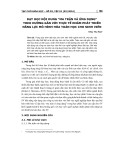

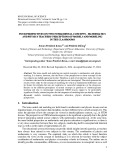

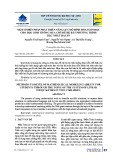
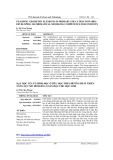
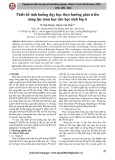
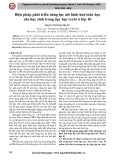
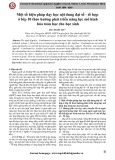
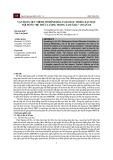


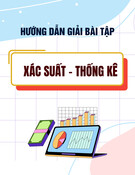







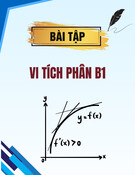
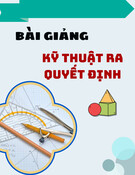
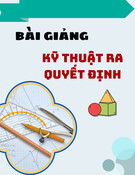
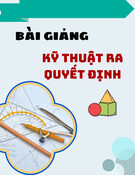
![Quyển ghi Xác suất và Thống kê [chuẩn nhất]](https://cdn.tailieu.vn/images/document/thumbnail/2025/20251030/anh26012006/135x160/68811762164229.jpg)
